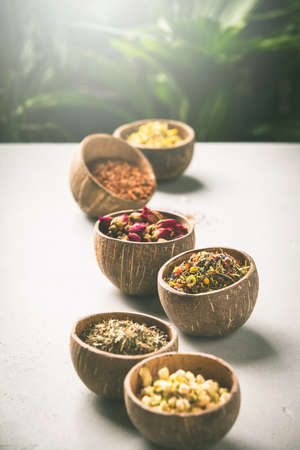Introduction to Indian Culinary Herbs
In every Indian kitchen, herbs play an indispensable role in shaping the unique flavours and aromas that define traditional dishes. From the bustling streets of Mumbai to the serene villages of Kerala, fresh herbs are woven into the very fabric of Indian cooking, reflecting the country’s deep-rooted connection with nature and home-grown produce. These greens are more than just flavour enhancers; they symbolise wellness, prosperity, and the art of nurturing one’s family through food. Across generations, families have cultivated essential herbs in their courtyards, balconies, or even small kitchen pots, ensuring a steady supply of fresh ingredients for daily meals. The use of home-grown herbs like coriander (dhaniya), mint (pudina), curry leaves (kadi patta), and holy basil (tulsi) is not only a testament to sustainability but also a celebration of India’s rich culinary heritage. Exploring the significance of these herbs reveals how deeply entwined they are with cultural rituals, festive preparations, and everyday nourishment in Indian households.
Popular Indian Herbs and Their Benefits
India’s vibrant culinary landscape is deeply rooted in the use of fresh herbs that not only enhance flavour but also add a healthy touch to everyday meals. Across urban balconies and rural courtyards alike, growing staple herbs is a time-honoured tradition. Here’s an overview of five must-have Indian herbs—coriander (dhania), mint (pudina), curry leaves (kadi patta), fenugreek (methi), and holy basil (tulsi)—along with their unique culinary uses and health benefits.
Coriander (Dhania)
Coriander is a true kitchen essential, lending freshness to chutneys, curries, and salads. Beyond its zesty flavour, coriander leaves are known for aiding digestion and providing vitamin C. The seeds are often used in spice mixes like garam masala.
Mint (Pudina)
Mint brings a cool, refreshing twist to dishes such as pudina chutney or summer drinks like nimbu pani. Its aromatic leaves help soothe the stomach and relieve headaches—a classic remedy in many Indian households.
Curry Leaves (Kadi Patta)
No South Indian tadka is complete without curry leaves. They infuse dals and sabzis with a characteristic aroma. Rich in antioxidants, curry leaves support healthy hair growth and aid in managing blood sugar levels.
Fenugreek (Methi)
Methi leaves feature in parathas and the beloved methi thepla of Gujarat. Both the greens and seeds are prized for their ability to manage cholesterol and boost lactation in new mothers—a testament to their trusted place in Indian kitchens.
Holy Basil (Tulsi)
Tulsi holds sacred status, often found growing in a special courtyard spot. Used in herbal teas and home remedies, it is renowned for its immunity-boosting properties, stress relief, and respiratory benefits.
Comparison Table: Culinary & Health Benefits
| Herb | Culinary Use | Health Benefits |
|---|---|---|
| Coriander (Dhania) | Chutneys, curries, salads | Rich in vitamin C, aids digestion |
| Mint (Pudina) | Chutney, drinks, raita | Soothes stomach, relieves headaches |
| Curry Leaves (Kadi Patta) | Tadka for dals/sabzi | Antioxidants, supports hair growth |
| Fenugreek (Methi) | Theplas, parathas, curries | Lowers cholesterol, boosts lactation |
| Holy Basil (Tulsi) | Herbal tea, home remedies | Boosts immunity, relieves stress |
This blend of traditional wisdom and contemporary kitchen practices makes these herbs integral to every Indian home—adding not just taste but also holistic wellness to your daily meals.

3. Cultivation Methods in Indian Urban Settings
India’s vibrant cities offer immense opportunities for urban herb gardening, even within limited spaces like balconies, terraces, and compact home gardens. Here are practical tips tailored to Indian conditions, ensuring your culinary herbs thrive regardless of local climate or available water.
Choosing the Right Containers
Opt for earthen pots, recycled buckets, or grow bags—these are widely available at local nurseries and street markets across India. Ensure containers have drainage holes to prevent root rot, especially during the monsoon season.
Soil and Composting Tips
Mix local red soil with well-rotted cow dung or homemade kitchen compost for a nutrient-rich base. Adding sand improves drainage for herbs like coriander (dhaniya) and mint (pudina), which dislike soggy roots.
Optimising Sunlight Exposure
Most Indian herbs require 4–6 hours of sunlight daily. Place pots on south-facing balconies or sunny terraces. In hot regions like Rajasthan or Telangana, provide partial shade using old sarees or jute mats during peak summer afternoons.
Watering Practices for Indian Climates
Adapt watering to your local weather: in humid cities like Mumbai, water sparingly to avoid fungal diseases; in dry regions like Delhi or Ahmedabad, mulch with dried leaves or coconut husk to retain soil moisture. Early morning watering is best to reduce evaporation and keep plants healthy.
Space-Saving Planting Techniques
Practice vertical gardening with hanging planters, wall-mounted pots, or repurposed plastic bottles—an ideal solution for small flats. Companion planting (such as basil with tomatoes) maximises space and deters pests naturally.
Caring for Your Herbs
Pinch off flower buds regularly to encourage leafy growth in tulsi (holy basil) and methi (fenugreek). Use neem oil sprays as an organic pest control solution—a time-tested Indian remedy safe for edible plants.
With these practical approaches adapted to Indian urban life, anyone can transform their living space into a thriving herb garden, bringing fresh flavours straight from pot to plate.
4. Traditional and Modern Techniques for Herb Care
Successful cultivation of Indian culinary herbs requires a blend of traditional wisdom and innovative modern practices. Given the diversity of India’s climate zones and resource availability, it’s important to choose techniques that are both effective and sustainable. Below we explore key aspects such as organic methods, seasonal considerations, natural pest management, and eco-friendly practices tailored for Indian home gardens and urban spaces.
Organic Practices in Indian Herb Gardening
Many Indian households have long relied on organic methods passed down through generations. Using compost made from kitchen waste, cow dung, or dried leaves not only enriches the soil but also aligns with eco-conscious living. Avoiding chemical fertilizers preserves the natural flavour of herbs like tulsi, coriander (dhania), and mint (pudina). Incorporating traditional Panchagavya or Jeevamrutham as liquid fertilizers can further boost growth while maintaining soil health.
Seasonal Care: Timing Matters
| Herb | Best Sowing Season | Temperature Range | Watering Frequency |
|---|---|---|---|
| Coriander (Dhania) | Rabi (Oct–Feb) | 15–30°C | Moderate, twice a week |
| Basil (Tulsi) | Kharif & Summer (June–Sep) | 20–35°C | Light, thrice a week |
| Methi (Fenugreek) | Rabi (Oct–Feb) | 10–25°C | Regular, keep moist |
| Curry Leaves (Kadi Patta) | Anytime except peak winter | 18–32°C | Low to moderate, let soil dry between watering |
Natural Pest Management: Homegrown Solutions
Pest control in Indian herb gardens is best approached with locally available resources. Neem oil spray is highly effective against aphids and mealybugs. Intercropping herbs like marigold or garlic can deter many common pests naturally. For fungal issues during monsoon, a paste of turmeric or diluted buttermilk can be sprayed on affected plants. Avoid burning waste or using harsh pesticides which may harm beneficial insects and degrade soil health.
Sustainable Methods for Water and Soil Conservation
Given the variable water supply in many Indian cities and towns, adopting water-smart practices is crucial. Drip irrigation systems fashioned from recycled bottles or clay pot irrigation are ideal for balcony or terrace gardens. Mulching with coconut husk or dried leaves retains moisture and reduces weed growth. Compost pits can be established even in small urban spaces to recycle organic waste efficiently.
A Harmonious Blend: Tradition Meets Innovation
The key to thriving Indian herb gardens lies in harmonising ancestral knowledge with contemporary solutions. By respecting natural cycles, embracing low-impact inputs, and fostering biodiversity, urban gardeners and rural cultivators alike can nurture healthy herbs that add both nutrition and aroma to daily meals—while caring for the land they grow on.
5. Harvesting, Storage, and Usage Tips
How to Harvest Herbs for Maximum Flavour
When it comes to Indian culinary herbs like coriander (dhania), mint (pudina), curry leaves (kadi patta), and holy basil (tulsi), timing is everything for peak flavour. Harvest in the early morning after the dew has dried but before the sun becomes too strong. Use clean scissors or pinch with your fingers just above a leaf node to encourage bushier growth. For leafy herbs, such as coriander and mint, regular harvesting promotes new shoots and prevents flowering, which can make leaves bitter. Always avoid harvesting more than one-third of a plant at once to keep your herb garden thriving.
Traditional Indian Storage Methods
To maintain freshness and aroma, Indians have perfected storage techniques over centuries. For fresh leaves like coriander and mint, wrap them in a damp muslin cloth or paper towel, place in an airtight container, and store in the refrigerator—this method keeps greens fresh for up to a week. Drying is another time-honoured method: air-dry curry leaves and tulsi by hanging small bunches upside down in a well-ventilated area away from direct sunlight. Once dried, store them in glass jars or traditional steel dabbas. For seeds (such as fenugreek/methi), sun-drying is preferred before storing in airtight containers to prevent moisture and spoilage.
Kitchen Tips for Daily Recipes
Adding Fresh Herbs
Add chopped coriander or mint just before serving dishes like dal, sabzi, or biryani for a burst of freshness. Curry leaves should be tempered in hot oil (tadka) to release their aroma at the beginning of cooking.
Using Dried Herbs
Dried tulsi or curry leaves can be crushed between your palms and sprinkled into rasam, chutneys, or herbal teas for authentic flavours. Remember that dried herbs are more concentrated; use sparingly compared to fresh ones.
Quick Tip:
Store commonly used herbs close to your cooking space—either on windowsills or kitchen balconies—to make it easy to snip what you need while cooking. This not only enhances the taste of your food but also brings the joy of urban gardening into your daily life.
6. Common Challenges and Local Solutions
Growing essential Indian culinary herbs at home brings joy and fresh flavours, but urban gardeners often encounter several region-specific challenges. In this section, we address typical problems such as pests, monsoon protection, and resource constraints—offering tried-and-tested Indian solutions rooted in local wisdom.
Pest Control the Natural Way
Indian climates attract a variety of pests like aphids, mealybugs, and snails that threaten basil (tulsi), coriander (dhaniya), and mint (pudina). Many home gardeners swear by organic neem oil sprays—a traditional remedy for centuries. Mixing neem oil with water and a few drops of dish soap forms an effective, eco-friendly pesticide. Additionally, intercropping herbs with marigold or garlic is common in Indian terrace gardens, as their strong scents naturally repel many insects.
Monsoon Protection Tips
The Indian monsoon season can both nourish and damage delicate herb plants. Excess rainfall leads to waterlogging and root rot, especially in coriander and curry leaves. Urban gardeners typically elevate pots on bricks or install bamboo mats for better drainage. Some even construct simple overhead plastic sheet covers to shield herbs from heavy downpours while ensuring adequate sunlight—a frugal hack passed down in many households.
Resource Constraints and Space Management
Lack of space and limited access to quality soil are real concerns for city dwellers. Many Indian families recycle household items like paint buckets, broken clay pots (matkas), or old crates for vertical gardening. Composting kitchen waste—vegetable peels, tea leaves—is a popular method to create organic fertiliser without extra cost. In cities like Mumbai or Delhi, community compost pits are gaining traction among gardening enthusiasts.
Water Conservation Methods
With erratic urban water supply, efficient watering practices are essential. Using coconut coir mulch retains moisture in the soil—a tip borrowed from South Indian traditions. Drip irrigation with reused plastic bottles is another ingenious solution seen on apartment balconies across India.
Neighbourhood Knowledge Exchange
Finally, participating in local gardening groups (like WhatsApp or Facebook communities) enables quick troubleshooting tailored to your specific microclimate—sharing seeds, cuttings, and advice has always been part of India’s collaborative green culture.
By embracing these regionally adapted practices, anyone can cultivate a thriving patch of essential herbs—even amidst the unique challenges of Indian urban life.


